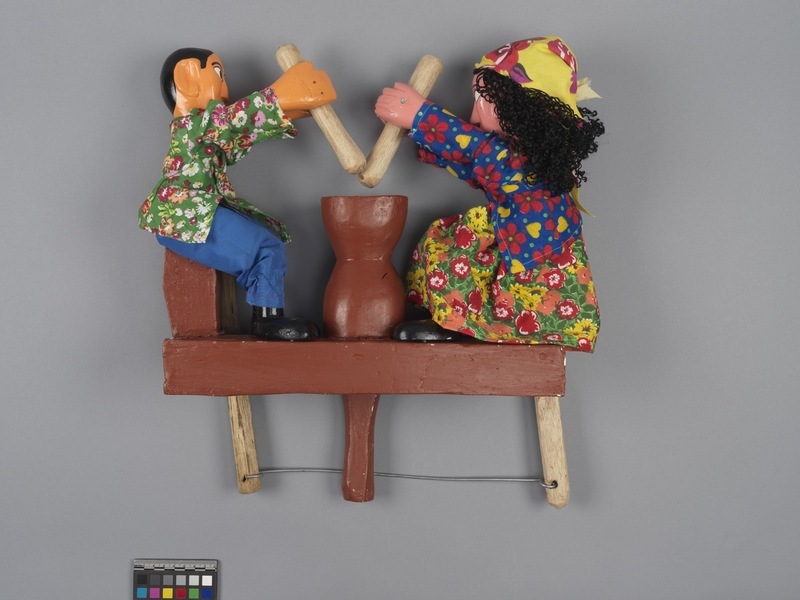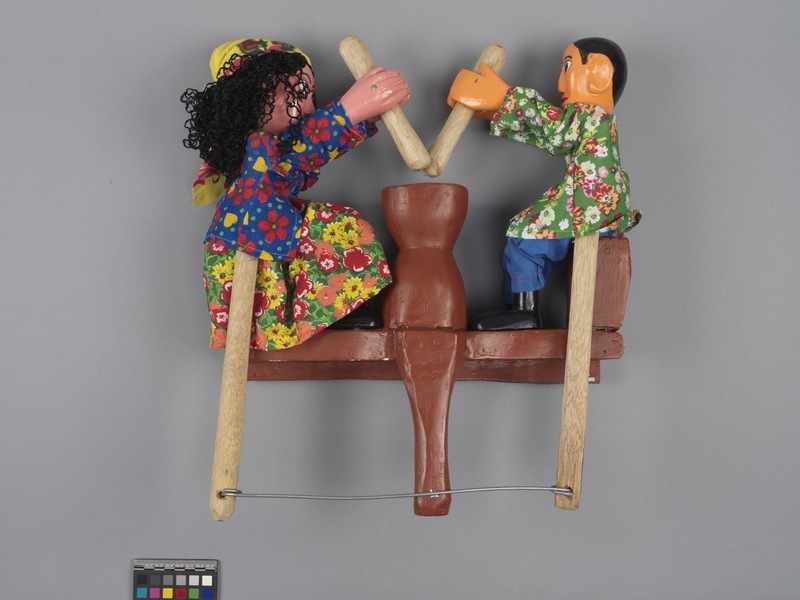Hand Puppet Item Number: 3381/20 from the MOA: University of British Columbia


Description
Mechanical hand puppet of a couple (one male, one female) each holding a pestle, working in the same central mortar. The mortar and platform are carved from wood and painted red-brown. The woman has pink skin. She wears a long dress that is green with yellow, red and orange flowers, a blue jacket with red flowers and yellow hearts, and a yellow floral scarf over her long, curly black hair. The man has orange skin. He wears a long sleeved green floral shirt, and blue pants. They both have painted black boots. Operated by two connected rods that are attached to each puppet's torso to control their arm movements.
History Of Use
From a form of popular puppet theatre found in northeastern Brazil, called mamulengo. This type of theatre is prevalent in disenfranchised communities with ancestral ties to colonized Indigenous peoples and uprooted, enslaved Africans. Mamulengo performances are entertaining events that can last all night long, with puppeteers (mamulengueiros) using 70 to 100 puppets in one staging. The stages are pop-up stands (empanadas), made of brightly coloured, floral-printed cloth. The shows consist of short sequences (passagens), or skits from popular stories that expose the inequalities and dramas of everyday life, profiling stock characters such as rich landowners and peasant labourers. The whole is spun together with humour, satire, lively music, and audience commentary.
Iconographic Meaning
The figures represent Pisa - Pilão, a couple grinding corn.
Item History
- Made by Jacilene Felix de (Maker) in Gloria do Goita, Pernambuco, Brazil during 2018
- Owned by Associacao Cultural de Amigos do Museu de Folclore Edison Carneiro before July 25, 2019
- Received from Associacao Cultural de Amigos do Museu de Folclore Edison Carneiro (Seller) and Museum of Anthropology Exhibitions Budget (Funding source) on July 25, 2019
What
Who
- Culture
- Brazilian
- Creator
- Jacilene Felix de (Maker)
- Previous Owner
- Associacao Cultural de Amigos do Museu de Folclore Edison Carneiro
- Received from
- Associacao Cultural de Amigos do Museu de Folclore Edison Carneiro (Seller) and Museum of Anthropology Exhibitions Budget (Funding source)
Where
- Holding Institution
- MOA: University of British Columbia
- Made in
- Gloria do Goita, Pernambuco, Brazil
When
- Creation Date
- during 2018
- Ownership Date
- before July 25, 2019
- Acquisition Date
- on July 25, 2019
Other
- Condition
- good
- Accession Number
- 3381/0020